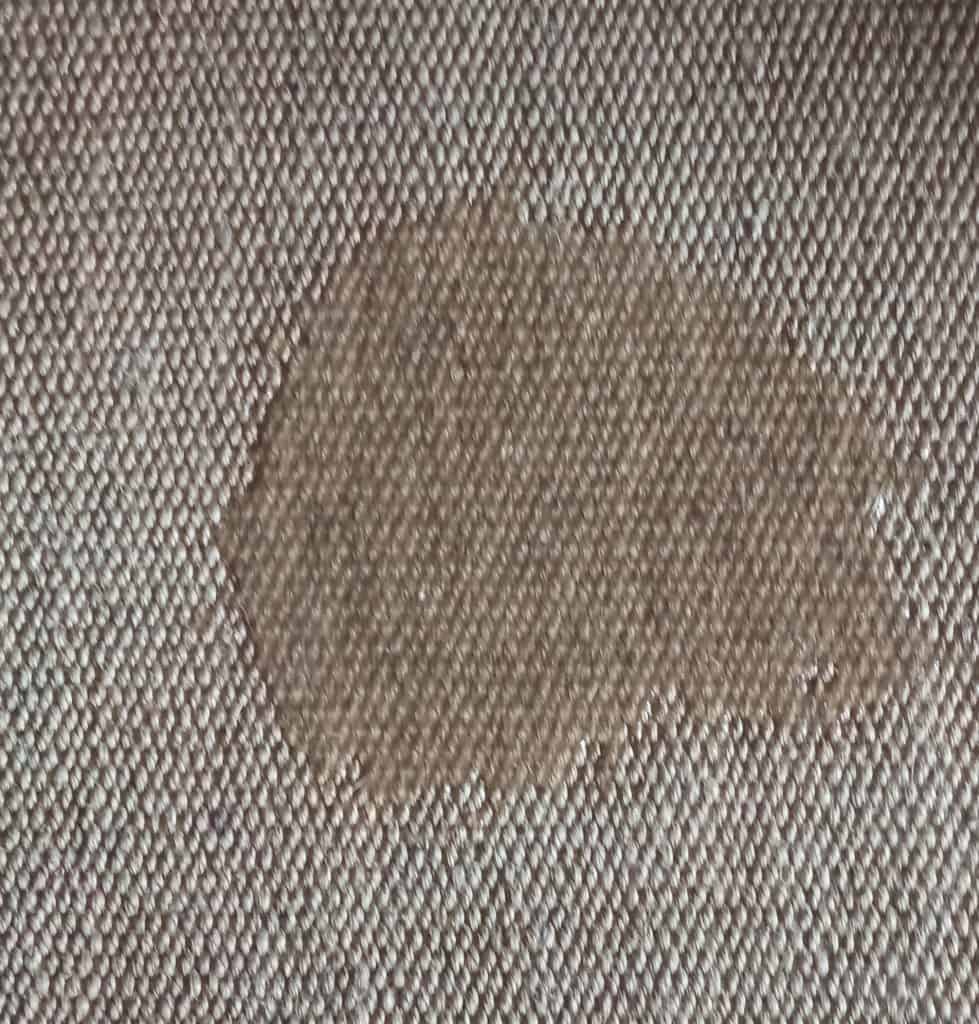
Many pet parents are confronted with this problem – their beloved dog lies down for a nap and when he gets up there’s an odorless wet spot left on the couch.
Even more baffling, the dog acts like nothing’s happened.
There’s no guilty look on his face like he knows he’s done something wrong.
Well, you shouldn’t be surprised.
The dog has no idea of what’s happened as these mysterious wet spots are usually caused by a problem he’s not aware of.
Such problems are most likely related to urinary incontinence and are more common among spayed females, dogs with a urinary tract infection or senior pets.
What you will learn from this article
- What are wet spots?
- Why are these wet spots odorless?
- Why do male dogs leave wet spots?
- Why do female dogs leave wet spots?
- Why do puppies leave wet spots?
- Why do senior dogs leave wet spots?
- Is there a natural remedy for curing wet spots?
- Are certain breeds more at risk than others?
- Are dogs with certain medical conditions more at risk?
- Closing Thoughts
What are wet spots?
Wet spots are puddles of a clear and odorless fluid that a dog leaves behind after sleeping or relaxing in his favorite corner.
In some cases, there are just a few drops, but in others there’s quite a big mess that the dog leaves behind.
Why are these wet spots odorless?
When you find a wet spot where your dog just took a nap, your first thought is that your dog must have had an accident.
If you have a house-trained dog it’s quite shocking.
What complicates matters even further is that the fluid appears to be odorless.
After weeks of house training you probably know only too well what your pet’s pee smells like.
How can it be urine then?
The answer is that it’s probably very diluted urine which is clear, almost watery and doesn’t smell.
If you feel like testing, you can dip a white tissue paper in the puddle and see if it stains.
However, this won’t tell you much.
Normal urine colors the tissue yellow, but even if it’s just a very pale yellow or clear, the most likely explanation is that it’s still urine.
The only thing you can do is leave the poor dog alone, clean the mess and then get an appointment with the vet to have your pet checked.
Why do male dogs leave wet spots?
If you have a house-trained male dog and he starts leaving wet spots where he sleeps, it’s probably a urinary tract infection, but it can also be a sign of an abnormality of the urinary tract or a symptom of a serious disease.
Here are the main causes of wet spots in male dogs:
Urinary tract infections
If your dog has an UTI it will probably make him pee more often. If you’ve ever had an UTI, you know the feeling. In many cases, you’ll notice your dog asking for a potty break more often, but it may very well be that your pet drips urine without being aware of it. If you suspect your dog might have an UTI, here are the main symptoms to watch out for:
- Accidents that occur when the dog is not sleeping
- Pain and whimpering during urination
- Excessive licking of the urinary opening
- Fever
Bladder problems
These may or may not be related to an UTI. When the bladder develops a storage problem, your dog might experience what is known as bladder hypercontractility. This means that his bladder contracts more often and quite suddenly, forcing the elimination of urine.
Urethral problems
This happens when the muscles controlling the urethra opening become weak and cannot keep the opening shut. Urethral weakness may be caused by a hormone imbalance, an UTI or inflammation, but also by a disease of the prostate.
Tumors
If your dog has a bladder tumor it will put pressure on the bladder forcing it to leak, which might explain the wet spot. At the same time, it might be a prostate tumor that’s causing the problem. The prostate gland is located near the neck of the urinary bladder and that growth can put pressure on both the bladder and the urethra.
Neurological problems
Urinary incontinence may be caused by a neurological problem, such as a spine injury which affects the brain’s control over the bladder. In rare cases, it can be a brain tumor that’s messing up things making the dog incontinent.
Urinary tract abnormalities
An anatomic abnormality of the bladder or the urethra can be caused by a congenital defect, an injury or by a failed surgery.
Behavioral problems
A dog suffering from stress or anxiety might hold it in for long periods of time. Urine retention puts pressure on the bladder up to the point when a leak becomes inevitable.
Why do female dogs leave wet spots?
Spayed female dogs are more prone than males to leaving wet spots. According to research, 20% of spayed dogs develop spay incontinence within three years after the surgery. Spay incontinence is associated with reduced estrogen levels following the surgery. This affects both the bladder, which has a reduced capacity, and the urethra as the lack of estrogen weakens the muscles surrounding the opening. In most cases, the problem affects the bladder muscles, a condition known as Urethral Sphincter Mechanism Incompetence (USMI).
However, you should not ignore the problem considering it’s normal and there’s not much you can do about it. It may be spay incontinence, but the wet spot might also be sign of an UTI, a tumor or other problem. You need to see a vet and have them run a few tests on your pet. An infection can easily be cured with antibiotics.
Older females might also develop changes in the structure that support the vagina, leading to involuntary leaks.
Why do puppies leave wet spots?
The problem is more difficult to spot with puppies as owners often assume the wet spot was an accident. They will continue the house-training program and sometimes punish the little one for the accident, although the poor thing is not to blame.
Urinary tract infections are very common in puppies, which explains the occasional wet spot. Also, young dogs who have just moved to a new house are under a lot of stress, which can lead to urine retention and leaks.
Young dogs should also get checked for urinary tract abnormalities, such as ectopic ureters, which can cause accidents.
Why do senior dogs leave wet spots?
Older dogs, both male and female, are more prone to urinary incontinence as their muscles weaken. With females the problem is aggravated by low estrogen levels, but involuntary leaks are quite common among male dogs as well. In advanced stages, the dog might be dribbling urine while he walks around and be totally unaware of it.
Is there a natural remedy for curing wet spots?
When the wet spots are caused by a urinary tract infection, the problem can be solved with appropriate meds, usually antibiotics, prescribed by your vet.
However, with spay incontinence you can also try some natural remedies, such as:
Phytoestrogens
Since the incontinence problem is caused by reduced estrogen levels, you can try to correct the imbalance by giving your dog plant-derived estrogens. These can be found in many soy products or in ground flax seeds. Check out the supplements aisle at your local pet store or ask your vet for a prescription.
Saw Palmetto
Saw Palmetto is known for its anti-inflammatory properties, but it can also help strengthen bladder control and correct hormone imbalances.
Corn silk
This can help soothe an irritated bladder if the dog has an UTI. Also, corn silk is a good source of phytoestrogens which can help with spay incontinence.
Acupuncture
If your dog is afraid of needles he probably won’t like this. However, a few acupuncture sessions can alleviate urinary incontinence as the procedure stimulates the nerves that control the muscles in the urinary tract.
Are certain breeds more at risk than others?
All dogs can develop urinary incontinence, but the condition is more common among midsize and large dog breeds, those that weigh more than 45 pounds.
German Shepherds, Giant Schnauzers, Dobermans, Rottweilers, Old English Sheepdogs and Irish Setters are more prone to urinary incontinence and wet spots.
Bladder cancer is rare in dogs, but there are some breeds that seems more prone to it, such as:
- Scottish Terriers
- Beagles
- Wire Fox Terriers
- Shetland Sheepdogs
- West Highland White Terriers
If you have such a dog you should have him checked out by a specialist, as bladder cancer can often mimic an UTI, or even cause one. Various tests can be used to distinguish between cancer and an UTI. If it’s cancer, early detection and treatment can improve your dog’s survival chances.
Are dogs with certain medical conditions more at risk?
Wet spots can be a problem even with otherwise young and healthy dogs if they have an infection. Yet, age and some health issues put dogs more at risk of developing this embarrassing problem. For instance, obesity is associated with an increased risk of urinary incontinence. Other risk factors include diabetes, hypothyroidism and Cushing’s disease.
Closing Thoughts
Wet spots are a common problem among dogs, especially spayed females. If your dog leaves a wet spot behind, this is probably caused by urinary continence. The fact that the fluid is clear and odorless can be misleading, making people believe it cannot be urine. However, dogs with urinary incontinence usually leak diluted urine, which is watery and odorless.
While in females the problem is often associated with spay incontinence, wet spots can also be caused by UTIs, bladder problems, tumors or even behavioral issues.





